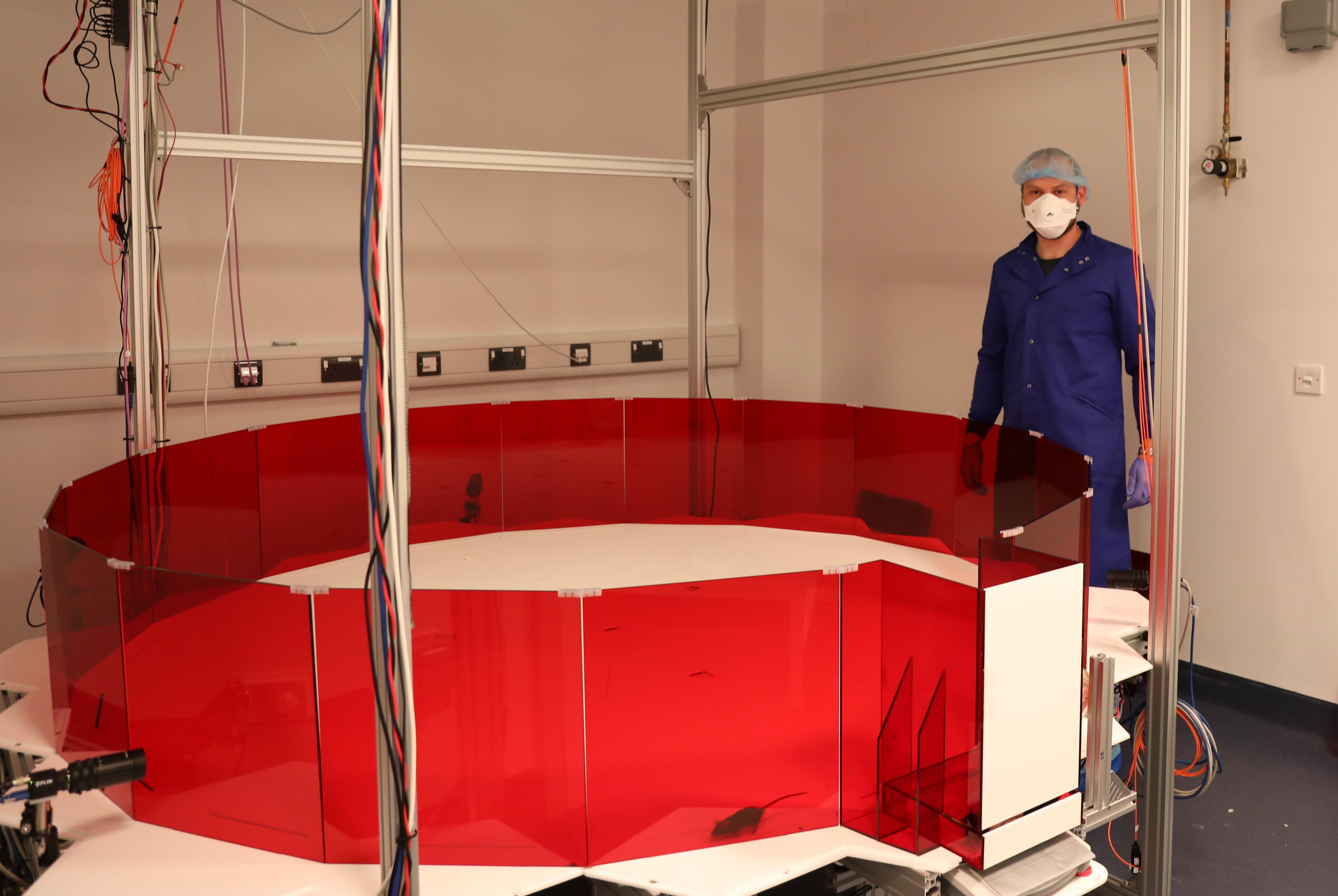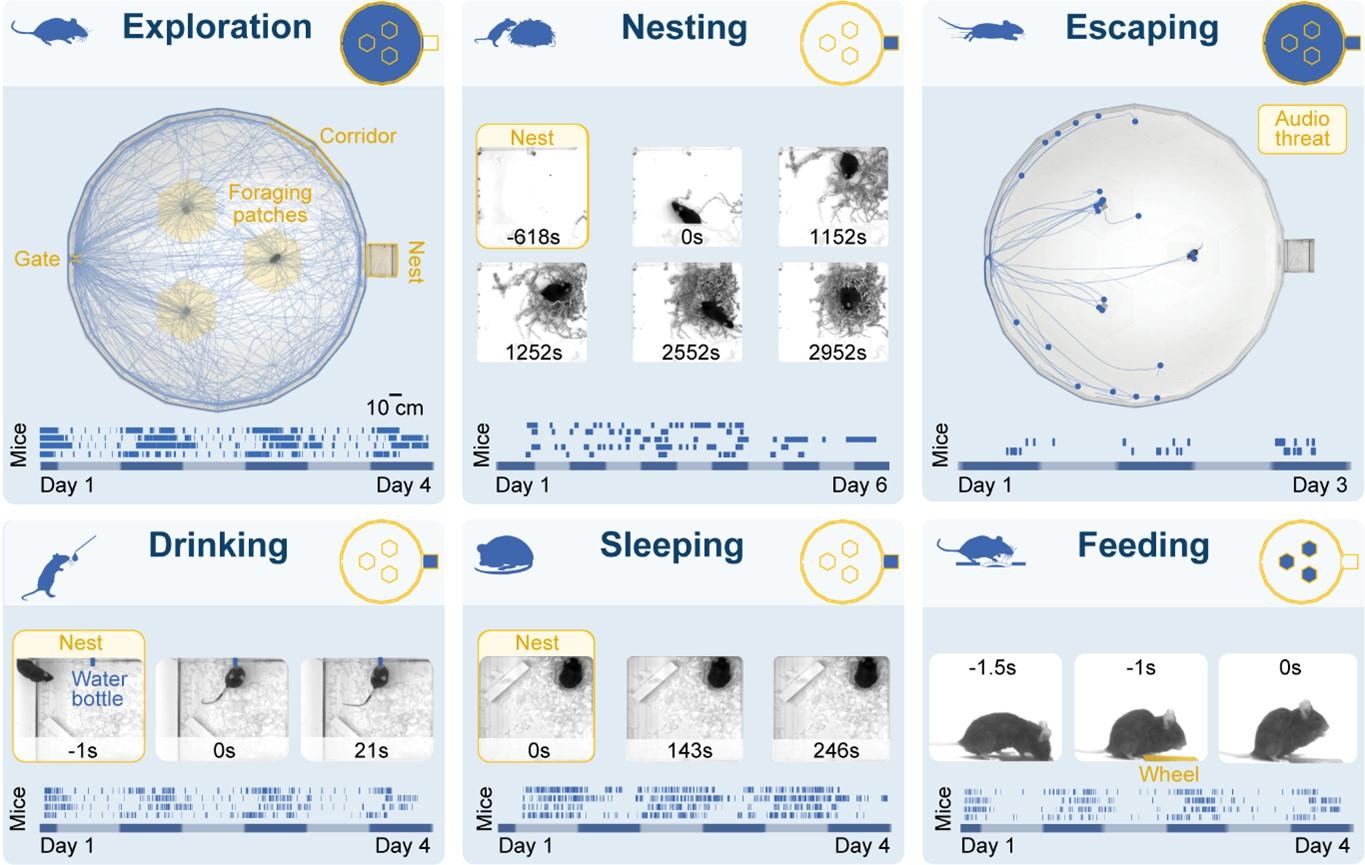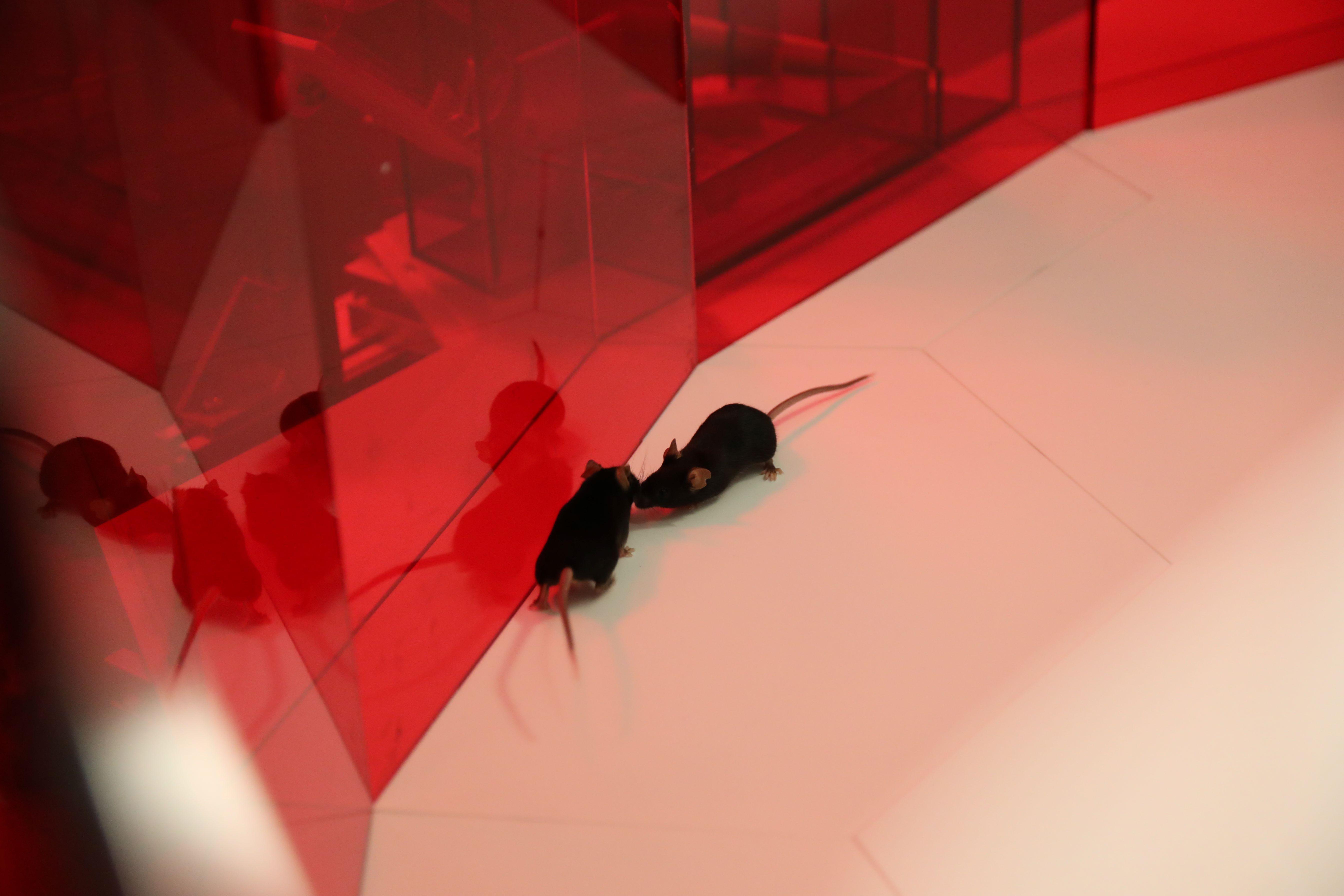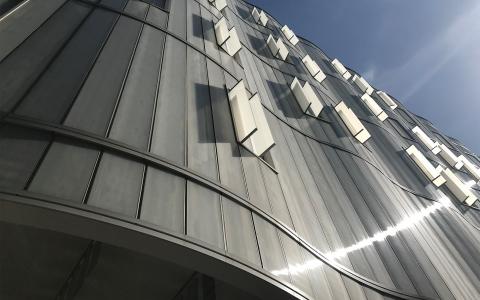
A new open-source system for behavioural research in neuroscience
By Alison Cranage
Studying animals in natural environments is a powerful tool to understand how the brain controls behaviour. Neural circuits in the brain have evolved to drive animals to find food and water, to nest, interact, navigate and much more – and studying these behaviours over extended time periods can reveal deep insights into how brain circuits function.
But until now, there have been limited ways for neuroscientists to measure brain activity, together with behaviour, in a naturalistic environment. To meet this need, researchers at the Sainsbury Wellcome Centre, the Gatsby Computational Neuroscience Unit, NeuroGEARS and DataJoint have developed a new experimental system - Aeon.
“Aeon incorporates as many natural behaviours as possible. We want to be able to study the brain doing what it has evolved to do.” – Dr Dario Campagner, Lead Scientist on the Aeon project and Senior Research Fellow at SWC and GCNU.
The platform enables scientists to make continual neural recordings and allows for high-resolution behavioural tracking of multiple mice living in large, enriched habitats over weeks or even months.
The modular system offers flexible setups, and it also handles the massive amounts of data generated by such long-term recordings. The hardware, software and tools are open-source and freely available.
So far, there are 15 research projects within and outside the SWC using Aeon modules, and the team hopes to go further. “We aspire to become the new standard for behaviour and electrophysiology experiments in neuroscience,” says Dario.

Dr Dario Campagner next to the Aeon habitat.
Behaviour in context
Work on Aeon began four years ago, and the project is now ready for researchers to adopt. The system is described in detail in a preprint published today, 1 August 2025, in bioRxiv. Dr Dario Campagner, Lead Scientist on the project, describes the key factors that drove the development of the system.
“Natural behaviours are unconstrained and influenced by a range of factors. Firstly, they take place in large spaces. Mice in the wild might travel hundreds of metres in one night. Behaviour takes place over timescales ranging from milliseconds to months, and finally, animal behaviour is swayed by other animals – there is a social context. These are all significant influences on behaviour and neural dynamics in most mammals,” says Dario. “We wanted a system that could measure all of these things, continuously and automatically.”

Figure illustrating the factors and scales influencing natural behaviour. Credit: Gil Costa.
Mice in the Aeon habitat naturally display the full range of behaviours seen in the wild — from exploring and foraging to nesting and socialising. For the team, confirming this was a crucial step. Another critical component is animal welfare, which is tracked 24/7 using automated systems. Researchers can receive notifications to their phones, via Teams, to alert them to progress, or any issues in the system.
“We collaborated closely with the Neurobiological Research Facility at SWC to meet all standards necessary for the continuous housing of animals in Aeon habitats”, says Jai Bhagat, Aeon Data Architecture & Social Experiments Research Lead, and Ph.D. student at the SWC.
Aeon features a modular, honeycomb floor that accommodates customizable, hexagonal modules such as nest boxes, corridors, and foraging wheels. Mice can move freely through the habitat, with their behaviour tracked via multiple cameras —both wide-angle and zoomed-in — to capture fine motor actions and social interactions.
Individual mice are identified using two systems: computer vision that tracks unique tattoos and body position via overhead cameras using SLEAP (a deep learning system for multi-animal pose tracking), and radio frequency identification (RFID) chips implanted in each mouse, detected by antennas embedded in specific habitat locations.

Examples of natural behaviours extracted from continuous, multi-day video. Plotted blue ticks represent the behavioural events. On the x-axis, light-dark luminance cycle: blue bars correspond to low luminance periods, while grey bars correspond to high luminance periods. Insets in the top right corner of each panel are schematics of the Aeon habitat: here blue areas indicate the regions where the respective behaviour was measured.
Key modules
A key innovation in Aeon is the foraging module: mice must spin a wheel to receive a food pellet, mimicking effort-based decision-making. Mice spontaneously learn how to use the wheel to forage for food. The module can be programmed to deliver food after varied amounts of time / effort – and analysis confirms that mice prefer high reward modules over lower ones.
Video of a mouse foraging in the Aeon habitat.
The Aeon system can also automatically detect and score social behaviours, including aggression and social hierarchy formation. For example, dominance is assessed through natural corridor interactions: when two mice meet in a narrow passage, the submissive one retreats. This behaviour mirrors the traditional ‘tube test’ but occurs naturally and continuously in the setup.
“Social behaviour and status are complex, dynamic, and continuously evolving. We have integrated analysis tools into Aeon so we can now track this evolution in fine detail over time,” says Jai Bhagat, Aeon Data Architecture & Social Experiments Research Lead.
To leverage the modular design of the habitat and data pipelines, experiment control must be precise, scalable, and adaptable. Aeon achieves this using Bonsai, an open-source, high-performance, visual programming language designed for synchronous and asynchronous data acquisition and online processing. Within Aeon, Bonsai orchestrates dynamic habitat updates, interfaces with hardware, and logs all experiment data.
Data acquisition
One of the main challenges for the team was creating systems for long-term data acquisition and storage, together with standardised and customisable analysis. During a typical experiment, Aeon will record from 30 unique hardware devices and 60 unique data streams. When including electrophysiology data from two Neuropixels probes, the total data can reach up to 200 GB per hour. The data are synchronised to microseconds precision using a HARP clock signal, and chunked into hour-long segments, which are then copied to a network storage location.
A general Python API enables researchers to directly query data streams from any experiment. DataJoint database routines can be flexibly configured to periodically ingest the data using this API into formatted tables as new chunks are recorded, allowing researchers to immediately start exploring the results while the experiment is running.
Jai commented, “Designing our low-level API and database was something we spent a lot of thought and effort on. A key design principle was ensuring that data could be queried intuitively and efficiently across space, time, and subjects. It was crucial to do this properly: the API and database is the foundation for how all future researchers will access and analyse Aeon experiment data.”
The team have already achieved one of the longest-ever continuous neural recordings using Neuropixels probes in freely moving mice - up to seven days. This was achieved by extending the Onix system (OpenEphys) to operate within the Aeon digital ecosystem and to support experiments in large enclosures. Technical challenges included managing long, chewable cables and ensuring power stability. They've now developed a thin, lightweight tethering system with a commutator to minimise behavioural interference and allow extended recording sessions. “Using this system we are now able to record from hundreds of neurons simultaneously and track the identity of the majority for the entire duration of experiments,” says Dario. “This unique feature of the platform allows us to study how learning shapes neural activity over several weeks and the contribution of individual cells in orchestrating different innate and learned behaviours. We have recently incorporated fiber photometry into the platform, to study neuromodulators’ dynamics over prolonged timescales.”
Future versions are expected to accommodate four Neuropixels probes simultaneously. This has driven efforts to implement live data compression and real-time spike sorting to manage the growing volume. The developers are actively exploring on-the-fly compression and streaming to reduce reliance on raw voltage storage.
Research results
The platform is already supporting major research initiatives at the Sainsbury Wellcome Centre, and beyond.
One of the projects at SWC focuses on social learning. By comparing foraging behaviour in solo and group housing conditions, researchers aim to uncover mechanisms of social learning, a process difficult to study with conventional short-term paradigms. Initial findings suggest that mice forage more efficiently when in social groups compared to being alone. Paired mice access rewards faster, explore more, and better identify the most rewarding foraging patches. This may stem from social learning, reduced anxiety, or increased exploration due to peer presence.
“The data architecture and pipelines we've built for Aeon has allowed us to quickly iterate on advanced analysis and modelling of complex, naturalistic, social behaviour over weeks-long, continuous timescales,” says Jai.

Two mice in an Aeon habitat.
Collaboration
“Designing and building this system goes beyond the capabilities of one lab. To do this, you need a wide variety of expertise and resources” says Dario.
The project is structured around a collaborative framework, involving a steering committee of principal investigators, postdocs, PhD students, technical staff, and several specialist companies. Contributions range from software development and hardware prototyping to experimental design and execution and data analysis.
One essential in-house contributor has been the Sainsbury Wellcome Centre’s fabrication laboratory (FabLab), which has been instrumental in conceptualising, developing and assembling the Aeon system. From the modular honeycomb habitat floor and its interchangeable behavioural modules to the specialised tethering apparatus that enables long-term neural recordings, the FabLab has provided best-in-class technical solutions. By leveraging advanced rapid prototyping technologies — including 3D printing, precision machining and custom electronics — the FabLab has enabled rapid design iterations, ensuring that Aeon’s physical infrastructure meets experimental needs rather than being constrained by off-the-shelf components. This in-house innovation hub has been key to overcoming technical challenges at pace and seamlessly integrating the diverse technologies required for Aeon.
"Aeon architecture makes it easy to reuse platform modules for different experiments. The standardised data formats for both behaviour and electrophysiology are paradigm agnostic, and therefore can be adapted to a broad variety of freely moving and head-fixed experiments. Having a unified data format will accelerate data sharing and collaborations across organisations.” - Gonçalo Lopes, Aeon Experiment Control & Data Acquisition Lead, and Director of NeuroGEARS.
“We hope this powerful integration of behavioural and neural data paves the way for mechanistic insights into how individual neurons contribute to adaptive and instinctive processes in ethologically relevant contexts.”– Dr Dario Campagner.

